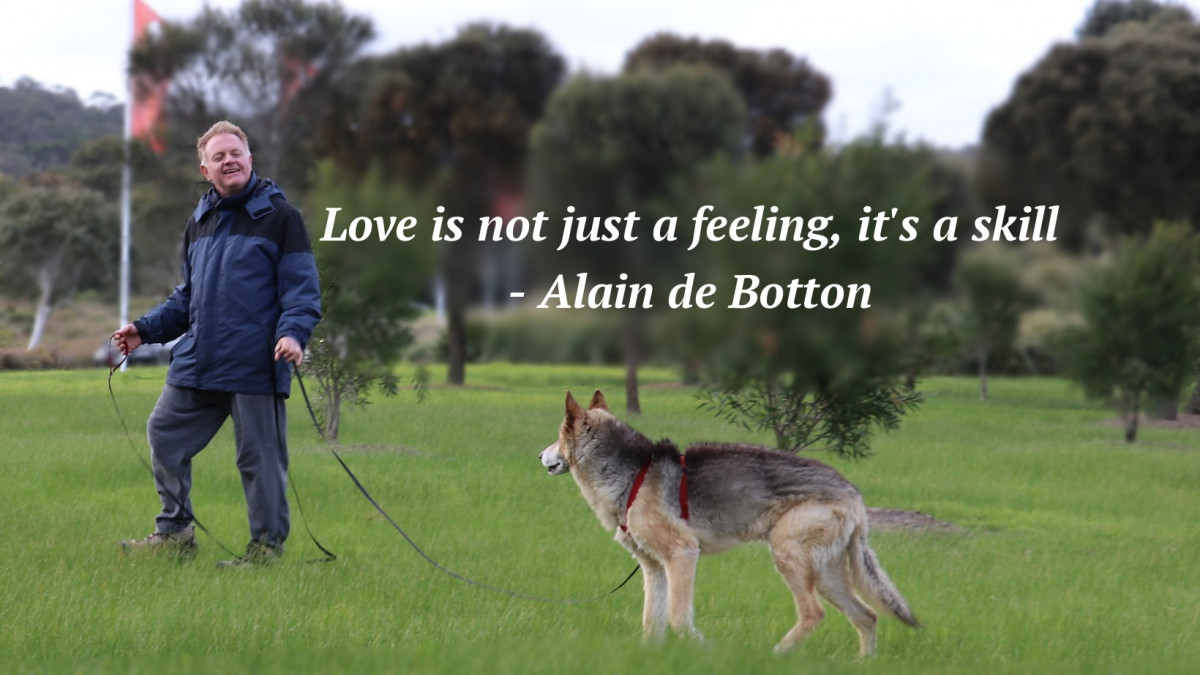For all the dogs who've touched our hearts
Connecting with dogs

Connection, love and companionship grow when we choose methods that support our relationship with dogs and when we apply these methods with skill.

Why train your dog?
If you ask most people why they train they'd say something like: to teach their dog manners or make him do as told. They may even say it's to enrich her life or have fun together. It pays however, to dig a bit deeper and see what we really want from training.
Dogs are messy, hairy, bark, dig and chew. They're expensive to care for and make life much more complicated, yet we bring them into our lives willingly and eagerly. We do this because of the joy, love and companionship they give – we do it for the connection we feel.

The way we train makes a difference
If connection's important, then the way we train makes a difference. Connection grows when we choose methods that support, build and motivate our dogs and when we apply these methods with skill.
Training a dog allows us to include them in what we do and makes our lives together so much easier. It is about developing a shared language, a language we both understand.
Connection is not a tether that ties one to the other without choice, it's choosing to be together. It is the essential glue in any successful relationship.
The joy is in the shared experience, watching them delight in being dogs and loving being part of that.
Connection impacts on almost every aspect of our lives with our dogs. Walking is easier, as the dog and you move in tune while remaining free to be yourselves. Grooming is easier, as you take the time to develop skills and earn your dog’s trust. It can even carry you through life’s darkest time, bath time, when connection may be all there is!

63044709d65b5_lg.jpg)

Connection needs realistic expectations
If we understand what's reasonable to expect from our dogs, we can accept them for who they are and remain supportive and connected.
Here’s an example:
I took Merlin for a walk in a place filled with people and dogs he had never met. He was so excited, all he wanted to do was sniff, say hello and explore. I knew this was going to be the case and managed him carefully, allowing enough freedom to enjoy himself but not so much that he could get into trouble. I made sure I was connected to him, even though he wasn’t connected to me.
It didn’t take long for his connection to return, and we enjoyed the rest of the day together. If I had expected our normal level of connection, I would have been frustrated, and fought him for control.
Connecting with dogs helps us understand their mindset and respond appropriately. It allows us to know if what we are doing is effective, enjoyable and to work out where more training is needed.
Never forget that connection is a two-way conversation – we cannot expect our dogs to be connected without appropriate teaching, guidance and connection from us.

How do we know we have connection
I want to answer this by saying connection feels comfortable, like putting on your favourite shoes, but I know this is not really helpful. The truth is, though, you do know it when you feel it.
Connection varies in different contexts and can be active or passive in nature. At the moment my dogs are lying next to me, one on the floor by my feet the other on the couch. They are both asleep and I am focused on this blog. I can, however, feel them there and if I get up and move, they will know where I am going.
When you are walking, training or playing, connecting with dogs looks different again. It is an active conversation: tug this? Chase that? Back scratch? Food? Toy? Sniff? Walk on by?
The key is being fluent in canine communication and knowing your own dog well. His ears may be swivelled towards you even though he is looking away, she may change speed or direction even though you don’t ask her to.
Learning to recognise and respond to these subtle signs can greatly enhance connection.
Perhaps one of the most intense connecting experiences happens when training. There's nothing like the thrill of connection when training goes well: watching the dog actively orientate for the next cue, respond with joy to hearing the marker and move with confidence to the reinforcer.



Connection is a practical skill
Connection is a philosophy of life, a way of choosing to live with our dogs, but it is not an airy- fairy idea. Connecting well involves developing many practical skills. We can utilise learning science and develop our own knowledge to learn about our beloved canine friend and build mastery over some basic know-hows.
I began formally learning about dogs 14 years ago when Rumble entered my life. I needed to give up what I thought I knew and really learn if I was going to have a good relationship with him. It took time, patience and there were many bumps in the road, but now I look back at our lives together with the satisfaction that connection brings.

Emma in Dog Land
My sincerest thanks to Sylvia for sending me this lovely email. It perfectly illustrates how knowledge can shift expectations and help improve a relationship through connection.



Hi Julie,
Emma my Jack Russell and I would like to say a big thank you for your 2019 Dog Blog.
We have both learnt a lot. I thought she was being naughty when she didn’t do as I asked her to do the first time, now I know she is in dog land and cannot quite hear me till I get her interest in what I am asking of her, it has made a lot better relationship between us both.
Thank you Julie, more please in 2020.
Sylvia and Emma . Woof xxx
For essential foundation skills check out these blogs:
Choosing and preparing food for successful dog training
Stop our dog mugging for food: a practical guide
Should you use food to train your dog?
Visit our YouTube channel for Instructional videos
References, resources and further reading
Learning about dogs, Kay Laurence
Behavior Works, Dr. Susan Friedman PhD
The Psychology of Expectations: Why unrealistic expectations are premeditated resentments, John A. Johnson PhD, Psychology Today
Connect to Thrive: Social connection improves health, well-being, and longevity, Emma Seppala PhD, Pschology Today
Why the secret to success is human connection, Jeff Boss, Word Economic Forum
Carrots versus sticks: the relationship between training methods and dog-owner attachment, Ana Catarina, Vieira de Castro, JenniferBarrett, Lilianade Sousa, I. Anna S.Olsson, Science Direct
New Literature Review Recommends Reward-Based Training, Zazie Todd PhD, Companion Animal Psychology
Dog Training Methods Affect Attachment to the Owner, Zazie Todd PhD, Companion Animal Psychology

You might also like


Comments


Comments
Never miss a thing!

 Julie van Schie
Julie van Schie 



